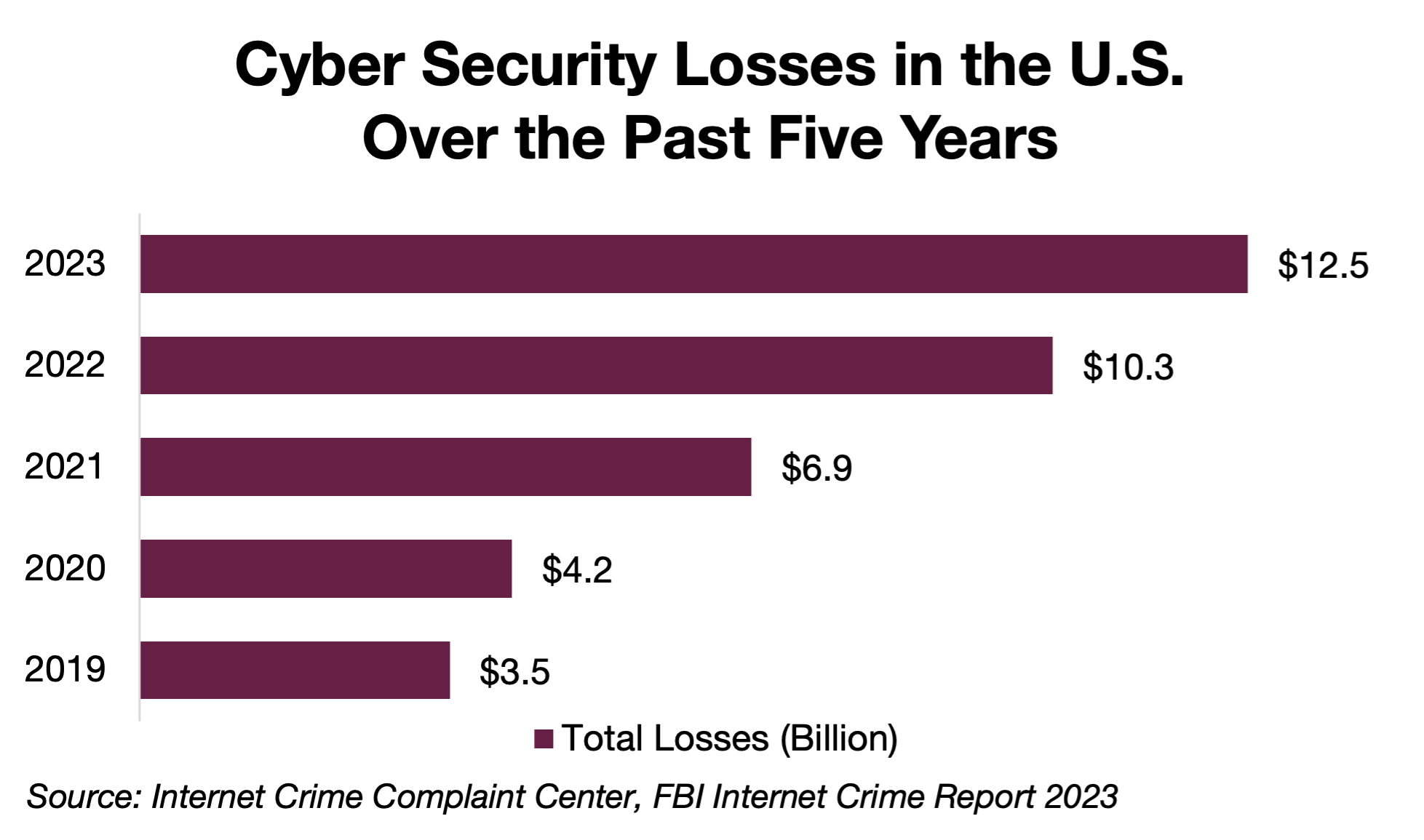Revisiting Artificial Intelligence
Exploring AI’s Ups and Downs as the New Tech Revolutionizes Society and Markets
BY GARRETT GUINN, CFA
Assistant Vice President
I vividly remember getting my first laptop, a clunky Lenovo, for Christmas in 2008. I felt so high-tech, watching YouTube videos and browsing the web at my leisure. Although my computer probably weighed a couple of pounds and performed relatively poorly to today’s standards, I was proud of my first taste of technology.
A few years later, I begged my parents for an iPhone, convincing them that they could keep tabs on me wherever I went using this neat thing called an “app” that you could download for free on the Apple App Store; that was an easy sell.
Fast forward to 2016, when I bought a fancy new Apple Watch with the money I saved working part-time in college. I was eager to display my smart watch at every opportunity, showing it off to my friends, family, or anyone else who might listen.
I didn’t recognize then that my attempt to simply show off became an appreciation for how technology was becoming more personal. Most recently, I raced to purchase the AirPods because they seamlessly integrated into the Apple ecosystem and my life.
Computation Gets One Step Closer
Today, Apple isn’t alone in developing wearable technology. Still, with Apple surpassing two billion active devices, it’s my favorite example of how computing has evolved from mainframe to wearable.
In fact, in February, Apple officially began selling its latest wearable device, the Apple Vision Pro headset, for $3,499. The headset competes head-to-head (pun intended) with Meta’s Quest 3 headset in the “spatial computing” realm. If you haven’t looked up the Vision Pro yet, I’d highly encourage you to do so — the advancement of this technology is incredible.
Analysts expect developers to launch artificial intelligence-specific apps in the coming months and years, sparking a new cycle of tech innovation similar to the smartphone.
While I’m not lining up to spend $3,499 on a headset yet, I can’t help but get excited about AI’s possibilities as we further embrace technology in ways that were essentially science fiction only a few years ago.
However, like previous technological advances, AI will bring along the benefits of innovation and adverse side effects. Below are a few developments related to AI that are top-of-mind, as well as trends that we believe deserve to be highlighted right now.
The Upside to AI
Recently, Gmail offered to unsubscribe me from several email lists I had never signed up for or were no longer relevant because I hadn’t read them. I know others share my frustration when random companies inundate our inboxes with useless promotions day after day. Without hesitation, I clicked “yes” to unsubscribe and went on with my afternoon, probably saving a few minutes.
I also can’t help but mention how much easier it is to write this article in Google Docs, which points out my spelling mistakes (very few) and offers helpful suggestions to improve readability.
While these two examples might seem unremarkable at first glance, it’s worth exploring how these and other adaptations of AI are making our lives increasingly frictionless. With Spotify’s recommended playlists based on my tastes and AI-summarized company earnings calls, life is getting incrementally better, and I can do more with less.
It’s also worth noting that many of AI’s uses won’t be directly observable in day-to-day life like the examples I provided; instead, businesses will likely implement AI behind the scenes to drive new insights and efficiencies.
Most recently, in the Journal of Clinical Oncology Clinical Cancer Informatics medical journal, GE HealthCare and Vanderbilt University Medical Center published promising data on AI models predicting patient responses to immunotherapy. These AI models could predict patient responses to immunotherapy with 70% to 80% accuracy. Thanks to the vast amount of input features, the models have the potential for wide deployment and adoption. GE HealthCare plans to commercialize the models, pending applicable regulatory authorization, focusing on pharmaceutical drug development and clinical support. In addition, the researchers claimed that there is long-term potential for use in other care areas, such as neurology and cardiology.
Another trend we’re observing is the rapid advancement in cybersecurity fueled by AI. Every week we hear about another company succumbing to cybercriminals, and millions of people are impacted by the increasingly digital world.
I was personally affected when Mr. Cooper Group Inc. (formerly Nationstar Mortgage Holdings Inc.), our mortgage servicer, had a data breach last year. In official filings with the SEC, the company admitted that hackers compromised the social security, birth date, and bank account numbers of nearly 15 million current and former customers and applicants.
Unfortunately, this story is nothing out of the ordinary and recurs all too often. The chart below (“Cyber Crime Losses in the U.S. Over the Past Five Years”) shows the staggering exponential increase in reported scams in the U.S. since 2019.

However, even though AI in this space is a double-edged sword (meaning criminals also have access to this technology), cybersecurity companies can leverage AI to thwart rising and sophisticated attacks.
According to Crowdstrike’s 2024 Global Threat Report, “… the rise of generative AI has the potential to lower the barrier of entry for low-skilled adversaries, making it easier to launch attacks that are more sophisticated and state of the art.” In response, companies like Microsoft, Palo Alto Networks, Crowdstrike, etc., are striking back with AI-enabled services to prevent, detect, and respond to cyber threats more efficiently.
We’re encouraged to see more companies take proactive steps to safeguard data and invest in the requisite cybersecurity defenses. We view AI as a net positive for cybersecurity and expect companies to continue fortifying their defenses against cybercriminals.
The Downside of AI
At the outset, one of the fears of AI was that it would destroy jobs. Evidence points out that this is the case and that some jobs will likely be unnecessary now and in the future.
Last year’s four-month SAG-AFTRA strike in Hollywood directly confronted the threat from AI; among other resolutions, actors received protections against the unfettered use of artificial intelligence in recreating performances.
Most recently, however, Klarna CEO Sebastian Siemiatkowski reported that an AI chatbot does the equivalent work of 700 customer service agents; what used to require about 3,000 agents now only needs a little over 2,000.
Siemiatkowski claims he was upfront about how this technology replaces jobs, hoping it would spur policymakers into action. It’s becoming clear that what used to be a distant prediction is happening now. Society must start thinking about this fundamental shift in the workforce. An essential counterpoint to the threat of job loss, however, is that in the wake of technological disruption, there tend to be more jobs created than lost.
Another issue that is already causing problems around the world is deepfake content, essentially digitally manipulated, synthetic media that aims to mimic the voice and/or appearance of someone.
Since this is an election year in the U.S. and many other countries, billions of voters will have to contend with a deluge of fake content. A few months ago, news broke that the New Hampshire attorney general’s office was investigating reports of an apparent robocall that used AI to mimic President Joe Biden’s voice to discourage voters from coming to the polls during the primary election.
While this is a more extreme example with significant political repercussions, deepfake videos of celebrities like Oprah Winfrey and Piers Morgan promoting controversial self-help courses have also circulated the internet.
Thanks to the proliferation of deepfake content, voters and consumers must be even more discerning between what’s real and fake.
What Now?
Whether this rapid advancement of AI excites you or resurfaces chilling memories from “The Terminator,” it’s important not to get too carried away with whatever attention-grabbing headlines make the weekly rounds. Given the incredible speed and complexities involved, a more measured approach to the evolving technology is recommended.
At Trust Company of Oklahoma, we’re focusing on how AI will influence our investment decisions and evaluating attractive opportunities as they arise. We recently added a semiconductor ETF to the approved list, seeing this as a strategic way to invest in a diversified group of companies powering the AI boom with the necessary semiconductor chips.
As always, we’re committed to sound investing principles, investing in reliable companies, and maintaining a long-term approach.

GARRETT GUINN, CFA
Assistant Vice President
(918) 744-0553



